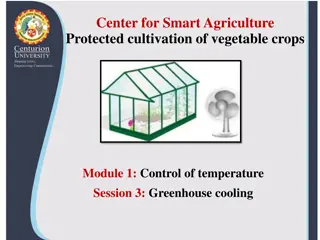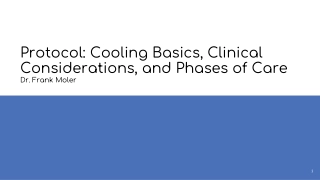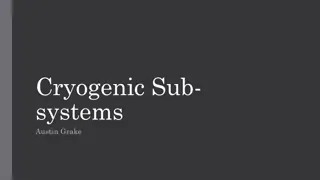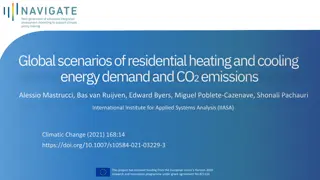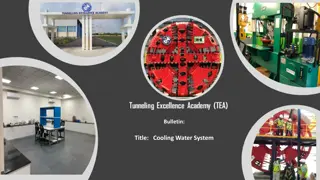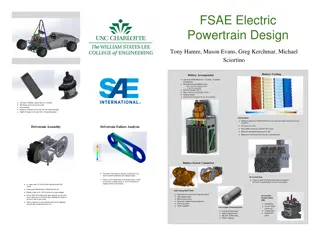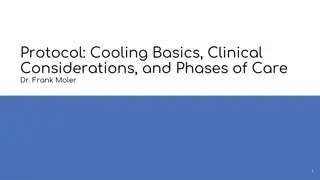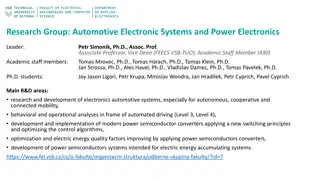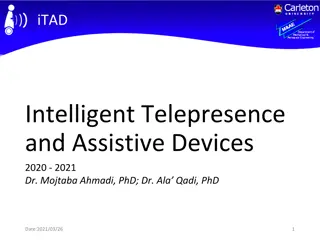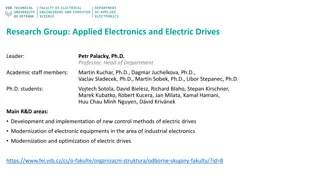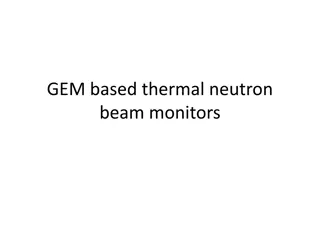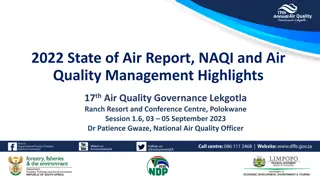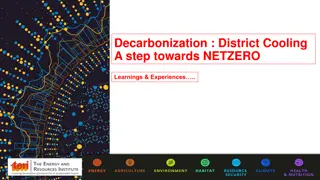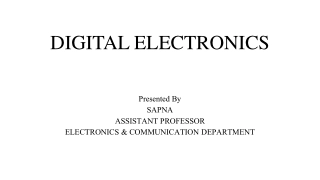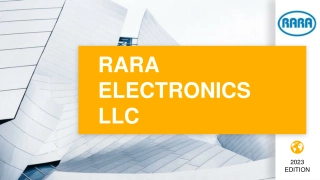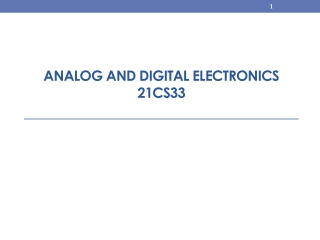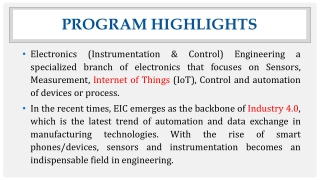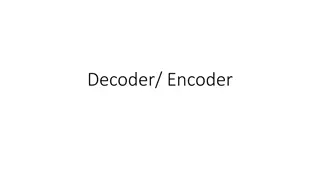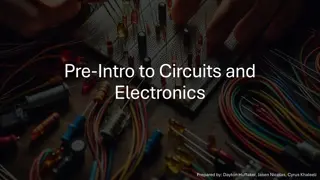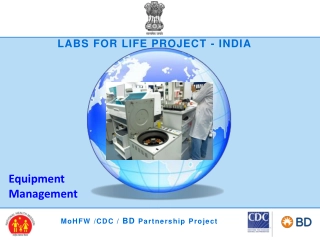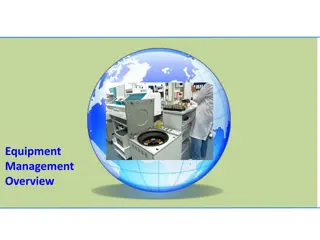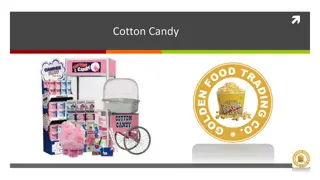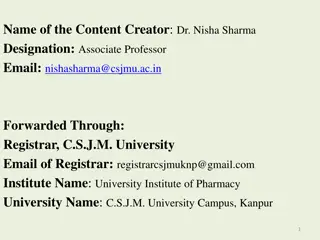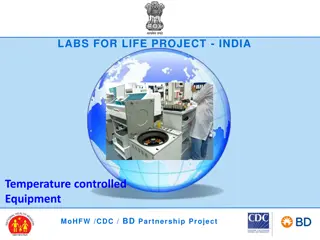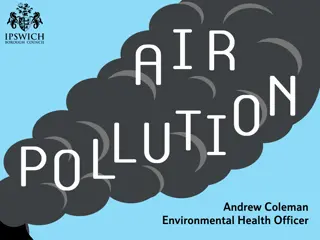Innovative Air-Cooling Equipment for Electronics
The design and use of air-cooling equipment in electronics to ensure environmental-friendliness is explored in this study by Vacek V. from Czech Technical University. The equipment is designed to meet demanding requirements for high-tech electronics applications, providing precise temperature regulation and dissipating heat effectively. The design utilizes vortex tubes and heat exchangers, offering temperatures down to -70°C and accommodating dissipated heat up to 1000 W. The devices have been successfully operated at the LHC accelerator at CERN, showcasing their reliability. Different sizes and types of air-cooling units have been constructed, including small two-stage units and large three-stage units with water precooling for high power applications.
Download Presentation

Please find below an Image/Link to download the presentation.
The content on the website is provided AS IS for your information and personal use only. It may not be sold, licensed, or shared on other websites without obtaining consent from the author. Download presentation by click this link. If you encounter any issues during the download, it is possible that the publisher has removed the file from their server.
E N D
Presentation Transcript
NEW RESULTS FROM THE DESIGN AND USE OF AIR-COOLING EQUIPMENT IN ELECTRONICS TO ENSURE ENVIRONMENT-FRIENDLINESS Vacek V. 1Department of Applied Physics, Czech Technical University in Prague, Technick 4, 166 07 Prague 6, Czech Republic,
NEW RESULTS FROM THE DESIGN AND USE OF AIR-COOLING EQUIPMENT IN ELECTRONICS TO ENSURE ENVIRONMENT-FRIENDLINESS Motivation Motivation There are cooling application for high-tech electronics such as: Sensors Detectors Imaging technology The applications are often very demanding Clean technology for clean rooms Environmentally friendly Strong magnetic fields Radiation
NEW RESULTS FROM THE DESIGN AND USE OF AIR-COOLING EQUIPMENT IN ELECTRONICS TO ENSURE ENVIRONMENT-FRIENDLINESS Motivation Motivation The usual requirements are: Temperatures from -70 to +15 C Precise temperature regulation Dissipated heat up to 600 W Very small form factor of the cold plate Quick and clean connection and disconnection of the cold plate
NEW RESULTS FROM THE DESIGN AND USE OF AIR-COOLING EQUIPMENT IN ELECTRONICS TO ENSURE ENVIRONMENT-FRIENDLINESS Design Design Our design uses the principle of vortex tubes and heat exchangers: It generates temperatures down to -70 C It is suitable for applications with dissipated heat up to 1000 W. Users benefit from are unattended operation, easy deployment The cooling is provided without any moving elements. The device is compatible with strong magnetic fields and radiation Several devices of our design have already proven their reliability by operating successfully at the LHC accelerator at CERN.
NEW RESULTS FROM THE DESIGN AND USE OF AIR-COOLING EQUIPMENT IN ELECTRONICS TO ENSURE ENVIRONMENT-FRIENDLINESS Design Design We have built several sizes and type of the Air-cooling equipment: Two-stage small units with up to 200Nl/min cold air flow Large three-stage unit with water precooling for high power and very low temperatures down to -70 C Small two-stage AIRCOOLING unit
NEW RESULTS FROM THE DESIGN AND USE OF AIR-COOLING EQUIPMENT IN ELECTRONICS TO ENSURE ENVIRONMENT-FRIENDLINESS Design Design We have built several sizes and type of the Air-cooling equipment: Two-stage units with remote second stage that eliminates unwanted heat ingress Air cooling installation in LHC tunnel
NEW RESULTS FROM THE DESIGN AND USE OF AIR-COOLING EQUIPMENT IN ELECTRONICS TO ENSURE ENVIRONMENT-FRIENDLINESS Cooling air production Cooling air production low-temperature cooling air production have been solved Second stage outlet -45 C First stage outlet -25 C Several hours long cooling lest
NEW RESULTS FROM THE DESIGN AND USE OF AIR-COOLING EQUIPMENT IN ELECTRONICS TO ENSURE ENVIRONMENT-FRIENDLINESS Cold plate heat exchanger Cold plate heat exchanger The problem with air cooling is the low heat transfer coefficient ( ) = . . Q h A T T w f Temperature difference Cooled silicon chips Surface area Heat Transfer Coefficient Examples of heat transfer coefficients: Evaporative cooling ~10 000 W/(m2K) Liquid cooling Air cooling Large surface area and high turbulence is needed for efficient air cooling of the cold plate! ~1000 W/(m2K) ~100 W/(m2K) Cold plate
NEW RESULTS FROM THE DESIGN AND USE OF AIR-COOLING EQUIPMENT IN ELECTRONICS TO ENSURE ENVIRONMENT-FRIENDLINESS Metal foam heat exchangers Metal foam heat exchangers There are few solutions for efficient air-cooled cold plates Machined fins or labyrinths Skived fins Metal foams
NEW RESULTS FROM THE DESIGN AND USE OF AIR-COOLING EQUIPMENT IN ELECTRONICS TO ENSURE ENVIRONMENT-FRIENDLINESS Metal foam heat exchangers Metal foam heat exchangers Open cell metal foam are interesting solution to promote efficient heat exchange The foams readily available even at small quantities They can be easily cut with simple tools Metal foam parameters Porosity* Characteristic pore width Tortuosity 0.93 dp 2.20 mm 1.32 RUC+ diameter d 2.62 mm Specific surface area A/V 0.62 mm-1 0 Foam surface area A 12.65 mm2 * cell volume fraction + RUC = representative unit cell
NEW RESULTS FROM THE DESIGN AND USE OF AIR-COOLING EQUIPMENT IN ELECTRONICS TO ENSURE ENVIRONMENT-FRIENDLINESS Metal foam cold plate heat exchanger design Metal foam cold plate heat exchanger design We have built three similar air-cooled cold plate heat exchangers: Machined fin labyrinth Copper open cell foam Aluminum open cell foam Machined fins Copper foam Aluminum foam
NEW RESULTS FROM THE DESIGN AND USE OF AIR-COOLING EQUIPMENT IN ELECTRONICS TO ENSURE ENVIRONMENT-FRIENDLINESS Test setup for heat exchanger evaluation Test setup for heat exchanger evaluation Our vortex tube based air-cooling device was used to test the heat exchangers Second stage vortex tube Tested cold plate heat exchanger Compressed air supply First stage heat exchanger
NEW RESULTS FROM THE DESIGN AND USE OF AIR-COOLING EQUIPMENT IN ELECTRONICS TO ENSURE ENVIRONMENT-FRIENDLINESS Test setup for heat exchanger evaluation Test setup for heat exchanger evaluation A test at small cold air flow quickly reveals the efficiency of each solution The machined fins perform very poorly, even the heat pickup from ambient air surrounding the cold place causes significant surface temperature increase The foam pressed inside the cold plate cavity performs significantly better than the machined fins Foam glued with thermally conductive epoxy inside the cold plate cavity performs even little bit better
NEW RESULTS FROM THE DESIGN AND USE OF AIR-COOLING EQUIPMENT IN ELECTRONICS TO ENSURE ENVIRONMENT-FRIENDLINESS Regulation and Control Strategies Regulation and Control Strategies The target applications often require very precise temperature control Use of I/P (Current-Pressure) controller and PLC can be used for regulation We have developed a control strategy for fast regulation that overcomes the high heat capacity of the first stage heat exchanger at minimum undershoot of the second stage target temperature Vaclav Vacek, Martin Doubek HEFAT 2022
NEW RESULTS FROM THE DESIGN AND USE OF AIR-COOLING EQUIPMENT IN ELECTRONICS TO ENSURE ENVIRONMENT-FRIENDLINESS Summary Summary Air cooling with vortex tubes is viable option for cooling of high-tech components It is ideal for cooling in clean laboratories, strong magnetic and radiation fields Suitable supply of dry compressed air are almost always available in these environments A vortex tube cascade can deliver cooling down to -70 C at flow up to 500Nl/min The challenge is to efficiently utilize the cold air in the cold plate heat exchanger Metal foams offer solution for high heat transfer that is easy to use and require no special tools unlike machining or skiving of thin fins. Vaclav Vacek, Martin Doubek HEFAT 2022





